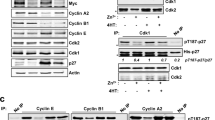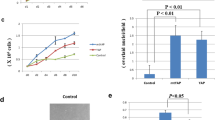Abstract
RAS proteins exert their mitogenic and oncogenic effects through activation of downstream protein kinases1. An important question is how Ras-generated signals reach the nucleus to activate down-stream target genes. AP-1, a heterodimeric complex of Jun and Fos proteins, which activates mitogen-inducible genes2, is a major nuclear target of Ras3. Ras can stimulate AP-1 activity by inducing c-fos transcription2,3, a process which is probably mediated by the ERK1 and -2 mitogen-activated protein (MAP) kinases4, which phosphorylate the transcription factor Elk-1/TCF5,6. Besides inducing transcription from fos and jun genes, mitogens and Ras proteins enhance AP-1 activity through phosphorylation of c-Jun7,8. Phosphorylation of the c-Jun activation domain leads to c-jun induction through an autoregulatory loop2. Ras- and ultra-violet-responsive protein kinases that phosphorylate c-Jun on ser-ine residues at positions 63 and 73 and stimulate its transcriptional activity have been identified9. These proline-directed kinases, termed JNKs, are novel MAP kinases10. It is not clear, however, whether c-Jun is the only recipient and JNK the only transducer of the Ras signal to AP-1 proteins. A short sequence surrounding the major JNK phosphorylation site of c-Jun is conserved in c-Fos and is part of its activation domain11, suggesting that c-Fos may be similarly regulated. Here we show that Ras does indeed augment the transcriptional activity of c-Fos through phosphoryla-tion at Thr 232, the homologue of Ser 73 of c-Jun. However, this is mediated by a novel Ras- and mitogen-responsive proline-directed protein kinase that is different from JNKs and ERKs. Therefore, at least three types of proline-directed kinases4 transmit Ras- and mitogen-generated signals to the transcriptional machinery.
This is a preview of subscription content, access via your institution
Access options
Subscribe to this journal
Receive 51 print issues and online access
$199.00 per year
only $3.90 per issue
Buy this article
- Purchase on Springer Link
- Instant access to full article PDF
Prices may be subject to local taxes which are calculated during checkout
Similar content being viewed by others
References
Egan, S. E. & Weinberg, R. A. Nature 365, 781–783 (1993).
Angel, P. & Karin, M. Biochem. biophys. Acta 1072, 129–157 (1991).
Herrlich, P. & Ponta, H. Trends Genet. 5, 112–116 (1989).
Thomas, G. Cell 68, 3–6 (1992).
Gille, H., Sharrocks, A. & Shaw, P. Nature 358, 414–417 (1992).
Marais, R., Wynne, J. & Treisman, R. Cell 73, 381–393 (1993).
Binetruy, B., Smeal, T. & Karin, M. Nature 351, 122–127 (1991).
Smeal, T., Binetruy, B., Mercola, D., Birrer, M. & Karin, M. Nature 354, 494–496 (1991).
Hibi, M., Lin, A., Smeal, T., Minden, A. & Karin, M. Genes Dev. 7, 2135–2148 (1993).
Dérijard, B. et al. Cell 75, 1025–1037 (1994).
Sutherland, J. A., Cook, A., Bannister, A. J. & Kouzarides, T. Genes Dev. 6, 1810–1819 (1992).
Bodner, M. et al. Cell 55, 505–518 (1988).
Feig, L. A. & Cooper, G. M. Molec. cell. Biol. B, 3235–3243 (1988).
Smeal, T. et al. Molec. cell. Biol. 12, 3507–3513 (1992).
Devary, Y. et al. Cell 71, 1081–1091 (1992).
Thomas, S. M., DeMarco, M., D'Arcangelo, G., Halegoua, S. & Brugge, J. S. Cell 68, 1031–1040 (1992).
Schonthal, A., Herrlich, P., Rahmsdorf, H. J. & Ponta, H. Cell 54, 325–334 (1988).
Chiu, R. et al. Cell 54, 541–552 (1988).
Kouzarides, T. & Ziff, E. Nature 336, 646–656 (1988).
Smeal, T., Angel, P., Meek, J. & Karin, M. Genes Dev. 3, 2091–2100 (1989).
Boyle, W. J., van der Geer, P. & Hunter, T. Meth. Enzym. 201, 110–149 (1991).
Landon, M. Meth. Enzym. 47, 145–149 (1977).
Alvarez, E. et al. J. biol. Chem. 266, 15297–1585 (1991).
Buday, L. & Downward, J. Cell 73, 611–620 (1993).
Kameshita, I. & Fujisawa, H. Analyt. Biochem. 183, 139–143 (1989).
Szeberenyi, J., Cai, H. & Copper, G. M. Molec. cell. Biol. 10, 5324–5332 (1990).
Blenis, J. Cancer Cells 3, 445–149 (1991).
Chen, R. H., Abate, C. & Blenis, J. Proc. natn. Acad. Sci. U.S.A. 90, 10952–10956 (1993).
Stokoe, D., Caudwell, B., Cohen, P. T. W. & Cohen, P. Biochem. J. 296, 843–849 (1993).
Kemp, B. E. & Pearson, R. D. Trend biochem. Sci. 15, 312–316 (1990).
Westwick, J. et al. Proc. natn. Acad. Sci. U.S.A. 91, 6030–6034 (1994).
Schlessinger, J. & Ullrich, A. Neuron 9, 383–391 (1992).
Angel, P., Smeal, T., Meek, J. & Karin, M. New Biol. 1, 35–43 (1989).
Arias, J. et al. Nature 370, 226–229 (1994).
Feigner, P. L. et al. Proc. natn. Acad. Sci. U.S.A. 84, 7413–7418 (1987).
Deng, T. & Karin, M. Genes Dev. 7, 479–490 (1993).
Green, S., Issemann, I. & Sheer, E. Nucleic Acids Res. 16, 369 (1988).
Ellis, L. et al. Cell 45, 721–732 (1986).
West, B. L. et al. Molec. cell. Biol. 7, 1193–1197 (1987).
de Togni, P., Niman, H., Raymond, V., Sawchenko, P. & Verma, I. M. Molec. cell. Biol. 8, 2251–2256 (1988).
Tratner, I., Ofir, R. & Verma, I. M. Molec. cell. biol. 12, 998–1006 (1991).
Author information
Authors and Affiliations
Rights and permissions
About this article
Cite this article
Deng, T., Karin, M. c-Fos transcriptional activity stimulated by H-Ras-activated protein kinase distinct from JNK and ERK. Nature 371, 171–175 (1994). https://doi.org/10.1038/371171a0
Received:
Accepted:
Issue Date:
DOI: https://doi.org/10.1038/371171a0
This article is cited by
-
EGFR Regulates the Hippo pathway by promoting the tyrosine phosphorylation of MOB1
Communications Biology (2021)
-
The AP-1 family of transcription factors are important regulators of gene expression within Leydig cells
Endocrine (2021)
-
Overexpression of RIN1 associates with tumor grade and progression in patients of bladder urothelial carcinoma
Tumor Biology (2012)
-
Water extract of edible bird’s nest attenuated the oxidative stress-induced matrix metalloproteinase-1 by regulating the mitogen-activated protein kinase and activator protein-1 pathway in human keratinocytes
Journal of the Korean Society for Applied Biological Chemistry (2012)
-
Rosiglitazone attenuates myocardial remodeling in spontaneously hypertensive rats
Hypertension Research (2011)
Comments
By submitting a comment you agree to abide by our Terms and Community Guidelines. If you find something abusive or that does not comply with our terms or guidelines please flag it as inappropriate.



